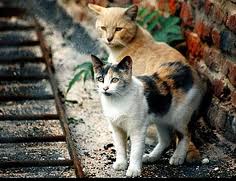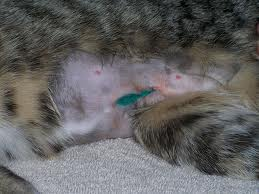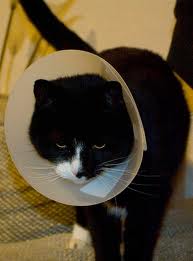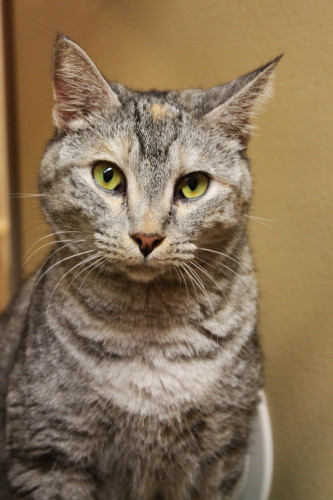Cat Neutering and Spaying

Cat neutering and spaying, also called the sterilization or “fixing” procedure, is a very common procedure. The term spaying indicates that the procedure was done in female cats, and neutering in male cats.
The primary purpose of having your cat spayed and neutered is to remove
the cat’s ability to reproduce. This procedure is also important to
help communities to control the number of stray cats.
Cat neutering and spaying prevents unwanted births and reduces the influence of sex hormones on pet's behavior. In seven years, an non spayed female and not neutered male cat can produce up to 781,250 kittens. And for the majority of these animals it will very hard to find homes, where many either end up in shelters or on the street. Sadly, only a lucky few are adopted, the rest are either euthanized or die from trauma, exposure, starvation or disease. By spaying or neutering your cat, you do your part to prevent this tragedy.
Cat neutering and/or spaying involves surgical removal of the reproductive organs and can only be done by a veterinarian. The procedure is performed by utilizing general anesthesia, the spaying or neutering procedures are safe and relatively painless. A spayed or neutered cat is usually up and moving around the day after the operation.
Normally clinics and veterinarians have you drop off your cat during morning, and the cat is usually available for pickup later that afternoon or sometimes the next day.
Most clinics and veterinarians try to keep charges for spaying and neutering affordable, you can also find assistance with foundations and cat rescue organizations. If you decide to adopt a cat from a shelter or other non-profit organization, most of them will have this procedure already done (in addition to vaccinations, deworming, and other tests).
The procedure does make some changes to your cat's metabolism, but it does not make them lazy or fat. Both neutered males and spayed females have a tendency to gain weight due to a decrease in roaming and other sexual behavior. However, weight gain can be prevented through dietary management. They will also become less distracted by their sexual instincts and more affectionate to family members.
Cat neutering and/or spaying procedure benefits.
• Female cats will have less desire to roam. They will have no heat cycles. The risk of mammary gland tumors, ovarian and uterine cancer will be reduced or eliminated. It will also help your cat to live longer and healthier.
• Male cats will also have less desire to roam, and to fight, and thus lowers chances of disease transmission (e.g., FeLV and FIV) and wounds. It decreases aggressive behavior, including scratching and biting. It will also help to reduce the risk of testicular cancer and prostate disease, and reduces or eliminates risk of spraying.
Unaltered cats have urges that make them irritable and anxious. They yowl or whine frequently, fight with other cats, and/or destroy objects in the house.
When should my cat have the procedure?
It’s a myth that female cats should have at least one litter before they are spayed. There are no health benefits to that at all, and it’s a much easier medical procedure if you spay before the first heat.
Traditionally female cats are usually spayed between 5 and 7 months of age. There are clinics that will offer the procedure to cats younger than 5 months, although most veterinarians will recommend to wait until 4 to 6 months before your pet undergo a general anesthetic procedure, it is much safer for them.
Male cats are usually neutered between 5 and 8 months of age, before habits such as spraying urine are started. Physically, male cats neutered prior to puberty do not develop the large head and thick skin of intact males.
Cat neutering is a very simple procedure, where the veterinarian will remove the source of sex hormones and sperm cells, which are the testicles. The incisions are usually so small that stitches or sutures are not even needed. And, normally, the cat is sent home the very same day.
How Do I Prepare My Pet for Surgery?
Your veterinary clinic will provide pre-surgical advice that you should follow. Do not withhold water, it is fine for your feline friend to drink water before the procedure.
In general, avoid giving your cat any food after midnight the night before surgery. A kitten, however, needs adequate nutrition, and your veterinarian may advise that food not be withheld.
Cat Neutering - Spaying Recovery Process.
Although your cat may experience some discomfort after surgery, he or she shouldn’t be in pain. Depending on the procedure performed, medication to control pain may be sent home with your cat.
Here are some tips for a safe and comfortable recovery:
•Provide your cat with a quiet place to recover indoors and away from other animals.
• Try to prevent your cat from running or jumping for the first few days following surgery.
• Prevent your cat from licking the incision site, by licking the wounds, the cat introduces bacteria into the wounds, making them wet and infected. If your cat won't stop licking, go to your Vet immediately and get an Elizabethan collar (E collar).
• Consider using shredded paper instead of cat litter, since dust from the litter can also cause infection.
• Avoid bathing your cat for at least ten days after surgery.
• Monitor the wound to ensure that it looks healthy and clean. Your cat should be back to normal within 1 to 3 days after the procedure.
If you notice any redness, swelling or discharge at the incision area, or if the incision is open, please contact your Vet immediately. Also call your Vet if your cat is lethargic, has a decreased appetite, is vomiting or has diarrhea following surgery.
Do Not self-mediate your cat with human pain-killers - they are toxic to cats.
No matter when you do it, please consider having your cat sterilized, so that he or she will have a longer and healthier life.
Related Articles:
Benefits of having multiple cats
New! Comments
Have your say about what you just read! Leave me a comment in the box below.Healthy Cat Treat

Subscribe to Our Love Cats Digest e-zine
"A cat improves the garden wall in sunshine, and the hearth in foul weather." - Judith Merkle Riley
Marketing Strategies by













New! Comments
Have your say about what you just read! Leave me a comment in the box below.